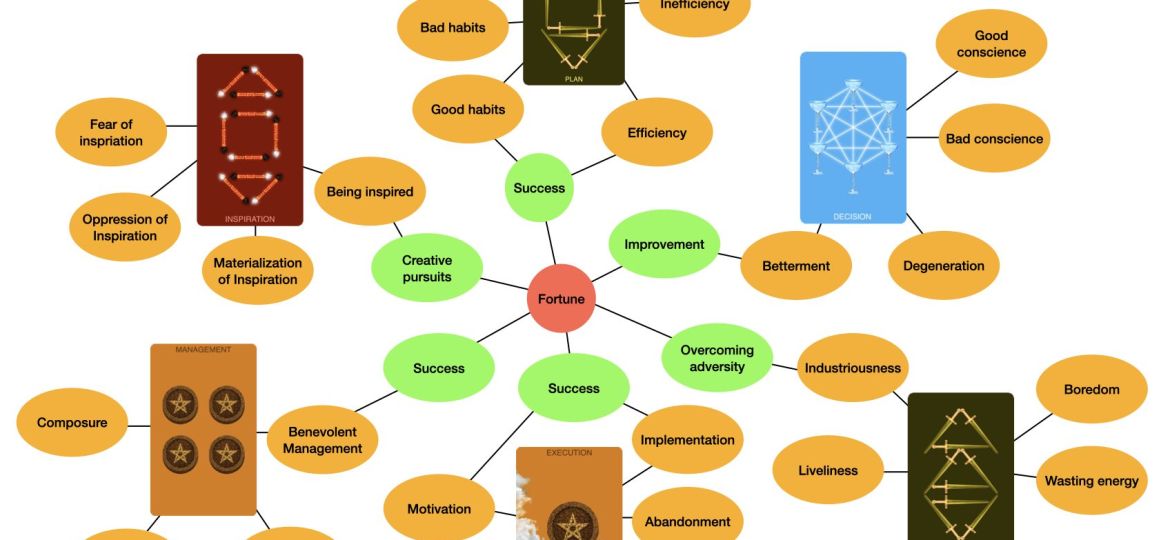
Have you ever felt that the meanings of Tarot cards are kinda fuzzy? And have you ever wondered why there are overlapping Tarot card meanings?
The reason for that is a lack of focus in interpreting the meanings of Tarot cards.
The mind works through associations. Like this: cold → winter → snow → skying → breaking a leg → hospital → health insurance. Such associations are random and can go on forever. If you close your eyes and watch your inner dialogue, you will be able to observe the associative movements of the mind.
Memories works through association too. The more we associate with a particular memory, the easier we can recollect it. Memorization techniques build on the mind’s associative faculty.
Tarot cards have multiple layers of meanings, like an onion. At the center is the core meaning, then it has primary and secondary and tertiary meanings, and so on.
The core meaning of a Tarot card is the power of consciousness it represents. The positive and negative application of the power of consciousness and the positive and negative experiences these applications produce constitute the primary meanings.
For instance, the core meaning of the Ten of Wands is materialization. The positive application is materialization of inspirations, and the negative application is oppression of inspirations. This leads to the inner experience of being inspired or being scared of inspirations. Inspirations can be scary because they can be life changing.
The associative drifts of the mind have lead tarotists, like Arthur Edward Waite, to secondary or tertiary meanings and tempted them to add those to the portfolio of meanings. As it turns out, many of these secondary and tertiary meanings overlap.
It’s time for an example. As mentioned, the core meaning of the Ten of Wands is materialization and the primary meanings are materialization of inspiration, oppression of inspiration, feeling inspired or fearing inspirations. Inspirations are the beginning of creative pursuits — that’s a secondary meaning — which can bring about fortune — that’s a tertiary meaning.

The Enlightenment Tarot title of the Six of Cups is decision. It’s primary meanings are decision, mediation, oppression, good conscience, and bad conscience. Mediation can turn around failing undertakings, which can bring about good fortune.
The Enlightenment Tarot title of the Nine of Swords is industriousness and its primary meanings are cognitive energy, productivity, busyness, excitement, and depression. Industriousness helps undertakings, which can lead to fortune.
The core meaning of the Ten of Swords is Plan. It’s primary meanings are functionalization, habitualization, enabling bad habit, functionality, and nonfunctionality. Functionalization helps bring about fortune.
The core meaning of the Ace of Pentacles is execution. It’s primary meanings are execution, implementation, imposing, motivation, and obstinacy. Motivation is one of the deciding factors of success and fortune.
The core meaning of the Four of Pentacles is management. It’s primary meanings are benevolent management, manipulative management, manipulation, concord, and discord. Proper management leads to fortune too.
All mentioned Tarot cards signify fortune, but in each case, fortune is brought about in a different way.
As you can see, associative interpretations of Tarot cards move the focus from the cause to the effect. In our example, fortune is the effect of materialization of inspirations, decision making, industriousness, good habits, execution, or management.
Revealing to the querent only the effect would rob the querent of the insight what ability is needed to further her undertaking or solve her adversity.
Another reason why tarotists came up with secondary and tertiary meanings is that they help with fortune telling. Fortune telling is dangerous because it leads to self-fulfilling prophecies. Imagine, all five of the mentioned Tarot cards showed up ill-dignified in a reading, and the Tarot readers interpreted them as indicators of misfortune. This would make the querent expect misfortune, which the law of attraction would bring it about. Self-fulfilling prophecies are bad for the querent and the Tarot reader, who will reap karma from inducing that self-fulfilling prophecy.
Psychological Tarot readings avoid fortune telling and instead, trace adversity and resistance back to the querent’s ignorance, weaknesses, or inner demons.
For this reason, the Enlightenment Tarot focusses on the core and primary meanings of each Tarot card. This give tarot readers five basic meanings to work with.
As mentioned, each Tarot card denotes a power of consciousness. An auspicious Tarot card (right side up) indicates which power of consciousness is the key ability that can further the querent’s undertaking or overcome her adversity. An inauspicious Tarot card (upside down), indicates the misuse of a power of consciousness, which may have caused the querent’s adversity or the stagnation of her undertaking.
Having said all that, it may be necessary to branch out into secondary and tertiary meanings on a case by case basis to explain the possible consequences of the use of powers of consciousness. But this is the job of the Tarot reader. The Tarot reader sees the entire spread, the connections between the cards, and relates to the querent. Only she is in the position to judge whether secondary and tertiary meanings may help the querent.
Would you like to read the story about how the Enlightenment Tarot came about? You can read it here.